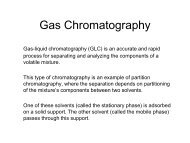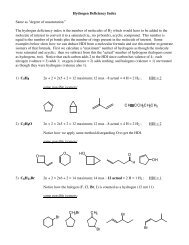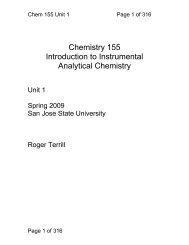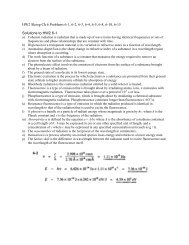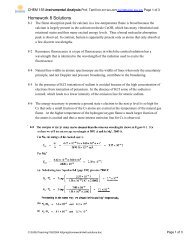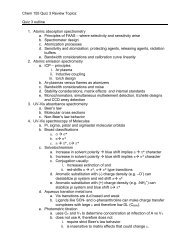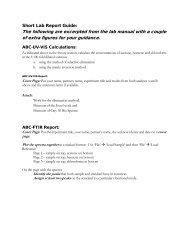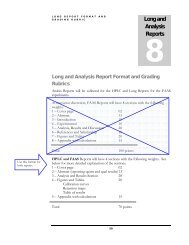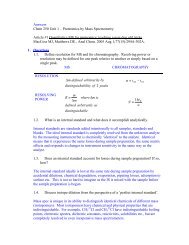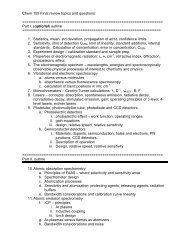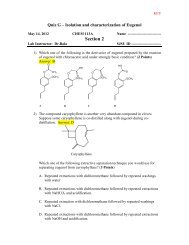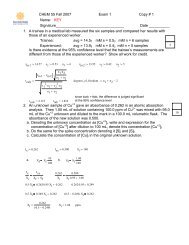November to illustrate the ways that their resources can be used to best serve JS students andinternship partners in terms <strong>of</strong> streamlining the initial part <strong>of</strong> the internship process. Along theselines, over the past two years, we have brought many more internship partners to campus for ourCareer and Internship Fair so that students and internship representatives have an increasedopportunity to meet each other in person.Finally, the JS undergraduate curriculum committee is currently in the process <strong>of</strong> reorganizingthe undergraduate curriculum into competency areas. Students will be required to take one ormore courses in each competency area, currently envisioned as theory; methodologies; global,historical and comparative perspectives; critical inquiry; analytical research and writing; andfield experience/practicum. In the course <strong>of</strong> this reorganization, both minor and majorcurriculum changes will also be proposed. This process is underway; several changes will besubmitted for department, college and university approval during 2007-2008, and others in thefollowing year.Graduate program: SLOs 1-1 through 1-3 are measured in JS 202, the required research methodsclass. Data indicate that a notable percentage <strong>of</strong> students have struggled to meet these learningobjectives, especially in Fall 2006. There have been several changes instituted and someproposals made to ensure that all <strong>of</strong> our graduate students achieve the research and data analysisobjectives that we have instituted. Beginning this semester, the instructor, Pr<strong>of</strong>essor MarkCorreia, has incorporated a tremendous amount <strong>of</strong> hands-on experience with SPSS—from dataentry to data organization and analyses. The goal <strong>of</strong> the assignments is for students to learn howto apply various statistical techniques using SPSS and how to interpret the outcomes to increaseachievement <strong>of</strong> SLO 1-2.Pr<strong>of</strong>essor Correia has also included a number <strong>of</strong> research based assignments in JS 202—providingstudents the experience <strong>of</strong> developing a research proposal as the final outcome. This change isintended to help students develop those skills necessary to be critical <strong>of</strong> the research they read(SLO 1-3). During the first half <strong>of</strong> each class, attention is given to research methodology, and inthe second half <strong>of</strong> the class, the focus is on statistical tools, logic, and the practical aspects <strong>of</strong>SPSS. This breakdown is intended to allow students to distinguish the broader issues related todesigning good research (SLO 1-1), and translating that knowledge into concrete projects throughthe application <strong>of</strong> research tools (SLOs 1-2 and 1-3).Finally, the graduate curriculum committee is considering other changes to the curriculum toensure that qualitative and quantitative methodologies are both adequately covered, and thatsufficient attention is devoted to statistical methods to enable students to be critical users <strong>of</strong>quantitative analysis.SLOs 2-1 to 2-4 are assessed in the graduate capstone seminar, JS 216. Data indicate that theseSLOs are being achieved by the vast majority <strong>of</strong> our students. While the assessment process hasnot prompted any curricular or pedagogical change, there is a plan to modify the course contentto more fully capture aspects <strong>of</strong> justice beyond the criminal justice system. This change is inkeeping with the department’s evolving curricular expansion, and with some <strong>of</strong> the changesalready instated in the graduate curriculum (especially the required theory course, JS 201). Thus,SLO 2-1 will be modified in accordance with the broader substantive curriculum in the graduate13
program, as assessed within the capstone course. The graduate curriculum committee is alsoconsidering developing an additional topical course in justice and inequality, to ensure that thecurriculum remains current and that graduate students have the opportunity to study emergingissues in the field.4. Students4.1 Analysis <strong>of</strong> Student Dataa. Status and trendsApplications. Applicants to the B.S. degree have increased steadily from 2002 to 2006 (the lastyear for which data is available). There were 304 freshman applicants in Fall 2002, 183 wereadmitted, and 49 enrolled. There were 805 freshman applicants in Fall 2006, 418 were admitted,and 102 enrolled—more than a doubling <strong>of</strong> freshman applicants, admissions, and enrollees in a4-year period. There were 177 transfer applicants in Fall 2002, 77 admissions, and 58 enrolled.In Fall 2006 there were 346 applicants, 233 admissions, and 125 enrolled—not quite a doubling<strong>of</strong> applicants, but more than doubling <strong>of</strong> admissions and enrollees. Although there were moretransfer applicants in Fall 2005 than 2006 (347 versus 346), there were more transfer admissionsand enrollments in 2006 than in any previous semester.Applications and enrollments in Spring semesters also show growth over time, but the numbersare smaller; 9 frosh applied in Spring 2003, 3 were admitted and 1 enrolled, as compared to 28freshman applications, 3 admissions and 1 enrollment in Spring 2007. As we would expect,transfer applications, admissions and enrollments in Spring semesters are greater. In Spring2003 there were 76 applicants, 32 admissions, and 26 enrollees, while in Spring 2007 there were165 applicants, 97 admissions, and 74 enrollees. The peak for Spring transfer applications wasin Spring 2005 (183 applicants), the peak for Spring transfer admissions was in Spring 2006 (116admitted), and the peak for Spring transfer enrollments was in Spring 2005 (77 enrolled).However, the decrease in enrollments from Spring 2005 to Spring 2007 was quite modest (downfrom 77 to 74).Thus, overall the department has shown significant growth in undergraduate enrollments in thelast four years.The M.S. program has seen more modest and uneven growth, from 36 applications, 26admissions, and 18 enrollees in Fall 2002 to 40 applications, 23 admissions, and 15 enrollees inFall 2006. Trends in Spring applications show a decrease over time, from 30 applicants, 22admissions, and 12 enrollments in Spring 2003 to 18 applicants, 9 admissions and 7 enrollmentsin Spring 2007. It appears that the current trend is for the bulk <strong>of</strong> graduate students to begingraduate study in the fall semester. Changes in application and enrollment rates in the M.S.program likely also reflect the higher GPA required for admission that was adopted during thereview period. Do we need to elaborate on this here if we cut it in the above section? No – it’salso covered in section 3.1.b. so I removed it from the executive summary.14



